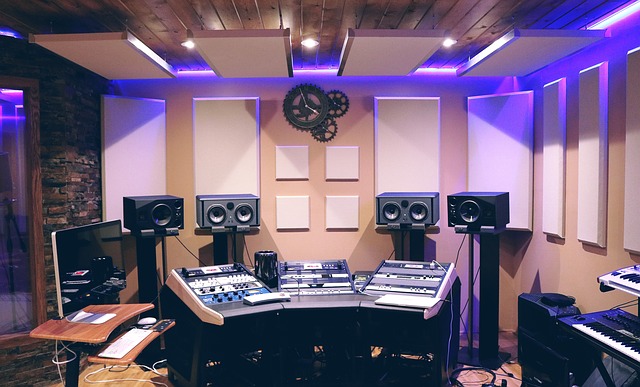
The acoustic effect of smaller practice rooms or classrooms has a volume of 30 to 200 m³. The mean reverberation time should be 0.4 to 0.8 s, i.e. relatively short in order to be able to hear and assess playing technique and precision well. However, some musicians prefer slightly longer reverberation times, as the impression of greater reverberation can contribute to increased joy in playing.
This is particularly important in music schools for children and young people. For this reason, a variable reverberation time is often provided, for example by placing a sound-absorbing fabric curtain in front of a wall, which can be opened or closed as required. In practice rooms with a grand piano, this curtain is most effective when it is placed to the right of the player.
The frequency curve of the reverberation time should be largely linear. This generally requires – in addition to the porous absorbers necessary to guarantee the required average reverberation time – the installation of sound absorbers for low frequencies. Plate transducers are mostly used for this. They should be installed alternately with the broadband sound absorbers on the ceiling and on one or two adjacent walls. This change in absorption properties produces somewhat diffuse reflections, which are desirable because the sound field then becomes more uniform. This can be supported at medium and high frequencies by designing the plate transducers in the form of cylinder segments or triangular structures.
Because of the risk of flutter echoes, parallel reflective room boundary surfaces should be avoided. In addition to various absorber arrangements and diffusely reflective surfaces, this can also be achieved through inclined partition walls or through built-in cupboards or shelves, door and window niches.
In the case of small rooms for music, particular attention must be paid to their geometric proportions with regard to the natural frequencies.
Sound absorption through curtains
Curtains and textiles represent a special form of a porous sound absorber, which is popular among other things where variable sound absorption properties are required, for example in music classrooms or in rehearsal rooms. Since the thickness is small, the effect extends mainly to high frequencies. If the middle frequency range is to be covered as far as possible, a thick, velvety material should be selected.
The specific flow resistance of the material should be in the optimal range between 1 and 3 kPa s / m. In the case of thin, less dense fabrics, this can also be achieved by double or triple folds, as these double or triple the specific flow resistance. Furthermore, a greater distance from the wall of the curtain is desirable. Then the curtain mass acts as a plate oscillator. This effect leads to an expansion of the frequency range towards lower frequencies.
In the case of a curtain with a mass per unit area of about 0.3 kg / m² at a distance of 0.2 m from the wall, for example, the focus of the frequency range extension would be 250 Hz. If a reduction in the distance were desired, this could be compensated for by increasing the mass by folding the curtain.

